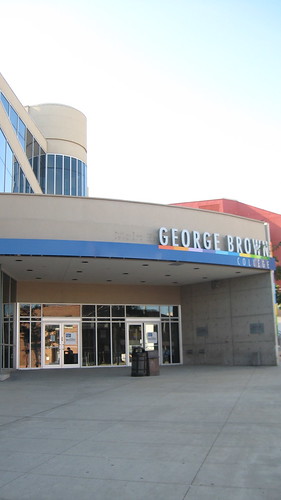
EDITOR’S NOTE: Spacing asked our summer intern Matthew Hague to visit all of Toronto’s post-secondary institutions and examine the built form of each campus. Every day over the next week, we will feature a campus profile.
– – – – – – – – – – – – –
George Brown College once branded itself “the city college.” This seems fitting, given that George Brown doesn’t maintain one campus, but has ingrained itself in Toronto’s urban fabric with campuses and buildings spread throughout the city. George Brown’s largest campus is the Casa Loma facility, situated on Kendal Avenue between Davenport Road and MacPherson Avenue, followed next in size by the St. James Campus around King and Frederick Streets, while the Yorkville School of Makeup and Esthetics and the Young Centre for Performing Arts are among the school’s other satellite facilities. George Brown also shares space on Ryerson University’s campus, operating classrooms and offices out of Kerr Hall, and the Sally Horsfall Eaton Building at Gould and Mutual streets.
George Brown has recently announced plans to develop a new East Bayfront Campus, on the south side of Queens Quay between Lower Jarvis and Lower Sherbourne streets. George Brown’s presence in the East Bayfront area, which is getting a facelift as a part of Waterfront Toronto’s redevelopment strategy, is meant to bring a critical mass of youth and students (the campus will increase enrollment capacity by 4,000 people) to animate the area’s public spaces and support new businesses — an interesting development for George Brown, which is seen more as a commuter school. What’s more, the East Bayfront campus will also have the school’s first residence, making it more likely that students will actually live there, as opposed to commuting in from elsewhere in Toronto and the GTA.
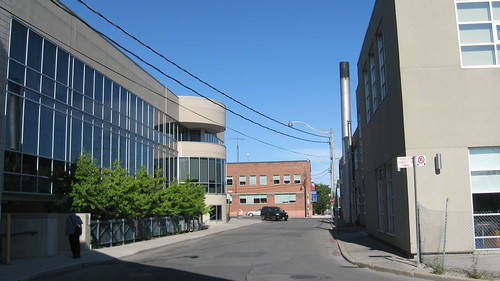
George Brown, like many Ontario colleges, was opened in 1967. It has a full-time student population of 15,000, with 60,000 students studying part-time. Although I have passed by some of George Brown’s buildings before, such as the cooking school on King Street and the Young Centre for the Performing Arts — a gorgeous space in the Distillery District that is shared with the Soulpepper Theatre Company — I decided to get to know the school better by visiting the main, Casa Loma campus. The campus is a short walk from Dupont subway station but is tucked quietly behind a train embankment near a leafy residential neighbourhood. The five campus buildings feel very unassuming. I walked onto the campus from the west, off Howard Street on Bridgman Avenue. Passing the Tarragon Theatre — one of George Brown’s Theatre program’s partners — I just sort of slipped onto the campus and if it wasn’t for the distinctive George Brown signage I wouldn’t have really clued into the fact that I was on a college campus at all. From this entry the campus feels more like a series of light-industrial buildings centered around a main, corporate looking office building .
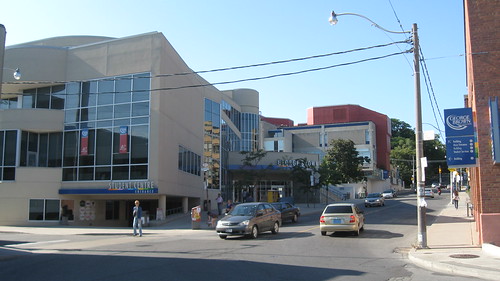
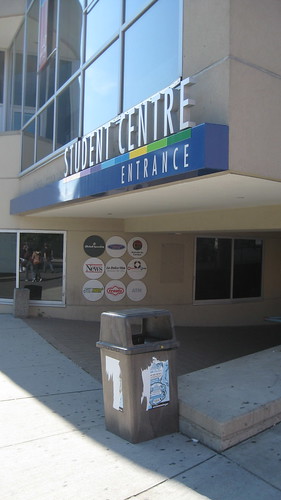

The main building is at 160 Kendal Avenue, which houses classrooms, workspaces, and administrative offices, as well as the Student Centre, is a cluster of glass and stucco volumes. The Student Centre is underneath the largest volume, ramped into the ground. Though subterranean, the centre is comfortable, with sitting spaces to watch TV, talk of play pool, as well as restaurants to grab something to eat.
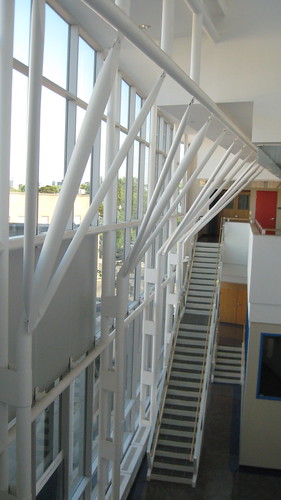
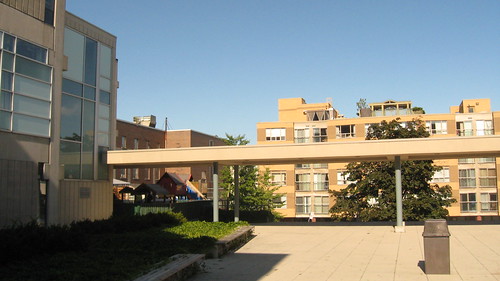
The Student Centre is connected to the rest of the building, so I wandered up through the main atrium and onto a forecourt space where I suppose that people stand around after class and smoke. The area was alright, but doesn’t compare to some of the other outdoor campus spaces in the city, like the parkette under OCAD’s Sharp Centre for Design, or the arboretum behind Humber. Lacking a lot of green or open space, I wonder where George Brown students go to get away, but in general the Casa Loma Campus isn’t known for offering a great social scene — even compared to the St. James Campus — as it has a high percentage of commuter students traveling from far away, as well as a generally older student population. The campus seems to reflect that feeling. As aside from the Student Centre and some nice views of Casa Loma and downtown, there wasn’t a very large draw to keep me there for long during my visit.
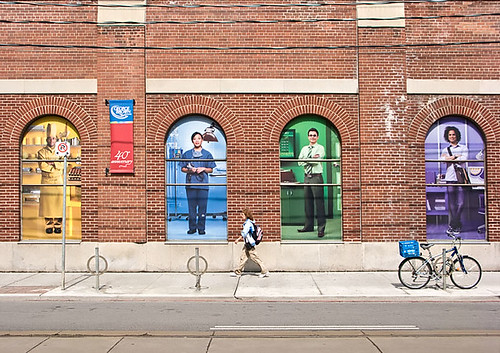
The St. James Campus in contrast is more vibrant, largely because of its more central downtown location, just east of Jarvis, around King Street. The campus is composed of four buildings and houses the popular hospitality and culinary arts programs. Last year, the Centre for Hospitality and Tourism announced an expansion program that includes a new storefront restaurant and kitchen at 215 King Street East. The new restaurant will help train chefs in George Brown’s culinary program in a real-world setting; the restaurant will serve lunch and dinner to the public daily, seating 70 people in an open-concept plan where patrons can look into the kitchen, and chefs can look back out at the patrons. The restaurant, called The Chefs’ House, replaces Siegfried’s, George Brown’s previous restaurant operation located within the hospitality school on Adelaide. By moving the restaurant outside of the school, George Brown hopes The Chefs’ House will have a more dynamic street presence and attract more patrons. The Centre for Hospitality and Tourism’s $20-million expansion program also includes adding 18,000 square feet of teaching space, allowing the school to increase enrollment by approximately 1,000 to 3,300 students over the next five years.
The St. James Campus, like Casa Loma, also lacks any substantial green or open spaces, but what it does offer is an accessible rooftop on the main building at 200 King Street East. The rooftop seems like a dynamic place to hang out before and after class, but is also a venue for concerts and fundraisers throughout the year. Ultimately, however, I suppose that the lack of open space might not be an issue for George Brown. Instead of having students hang out in a secluded courtyard, green space or even the adjacent parkette, students have the advantage of their downtown locations to get out and explore the city, which might be a more appealing option. In that sense, the whole city is the school’s open space, and being that all of George Brown’s facilities are conveniently accessed by the TTC, students can most likely find what they are looking for within walking distance or a short streetcar/subway ride.
Photo of St. James Campus by Reza Vaziri

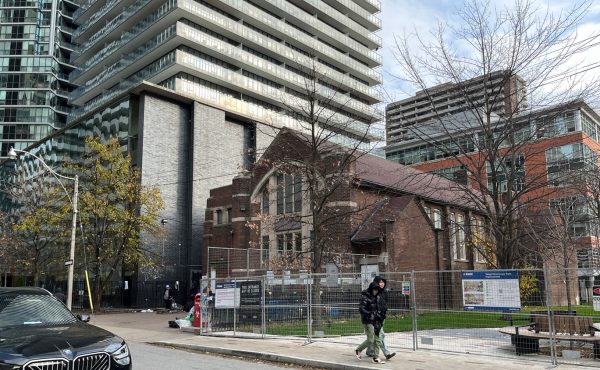

8 comments
If you are thinking of going to George Brown, St. James Campus, or George Brown at all for that matter, do not expect to live “the college social life” that the schools are always on about.
There is no social scene at george brown. None. Zip, zero. When I was a student two years ago at St. James Campus, out of the 30 or so people I had classes with, a grand total of three (including myself) lived within the pre-Megacity Toronto.
Like clockwork there is a mass exodus at 3-4pm of students to Union station to get on GO trains to spirit them back to Brampton or Ajax. Noone gets to know anyone else, because you’re going not sticking around after class.
If I sound bitter about it, its because I am, but I was stupid to think that other 18-year-olds would want to find an apartment downtown and go to George Brown College instead of living at home or going somewhere with a residence.
Though unloved and “ameliorated” by the present humdrum-albeit-humane 90s/noughts additions, the original GBC Casa Loma facilities (were they by Macy Dubois) are interesting for their no-nonsense bare-bones “Dutch Constructivist” overtones (one of many Brutalist variants at the time). Granted, it’s a detractor’s classic case of architecture that only an architect can love–though given the way time heals, it’s probably easier to attain that architect’s love now than it would have been a generation ago…
The largest building on the St. James campus used to be the Hallmark Cards factory before they moved up to the 401 in 1969.
certain programs such as fashion do indeed have an active social scene. at any school, the social scene is what you make of it.
bbpsi> Don’t the kids hang out at Betty’s?
I go to the casa loma campus. its comprised of alcoholics, drug addicts and teachers who hardly know how to teacher let alone speak english or form a single coherant sentance. i can imaging the hell the forgien students go through having to learn english and then baffle and be bewildered at the nonsence that goes on in this school. i think am the only sober person in the school. seriously cocaine,weed,alcohol ect even where it says NO SMOKING morons still smoke there and the security does nothing. and those pictures are way to clean the school is usually filthy and covered in cigarette buds and random garbage.
The St. James campus is full of drug addicts and alcoholics as well.
“The rooftop seems like a dynamic place to hang out before and after class, but is also a venue for concerts and fundraisers throughout the year.” Walking onto the rooftop patio, or out any number of exits leaves you light headed from the large groups of students getting stoned RIGHT OUTSIDE THE DOORS (security is only useful to harass students who are trying to enter to college after 6pm to use the library, they do nothing to reduce the homeless or drug dealers who wander the school) . There have been two fundraisers on the (extremely) dirty patio in the last 8 months. It is blanketed by cigarette butts and garbarge that has been sitting for months
(For example, a metalic pasta dish with 6+ month old pasta that even the pigeons wont eat. I noticed it in October (2008) when exitting the school via patio, and again last week when exitting via same route (March 2009)).
Also I have noted many homeless sleep, urinate, and beg on said rooftop patio (it has a staircase entrance from the street) The facilities themselves are grungy and subpar at best. The students and staff (most) alike are rude and ignorant. The library (Student Resource Center) has good hours (7AM- 11PM), but little in way of useful or up to date resources. If you commute from outside downtown expect to pay hundreds of dollars a month in parking.
Student services of any kind are nearly useless (aside from disability services, which are surprisingly very good). The bookstore gouges students to extreme levels. It took me a semester to realize that the U of T bookstore sells the same books for 20-40% (or more, seriously) cheaper. The student health insurance plan is a joke, it paid $7 towards my last ($120) dental check up!
A little on my program (Practical Nursing):
Although the Nursing Professors (for the most part) are quite good, the elective “professors” are unqualified in many cases to do thier jobs. The structure of the program is terrible too, first semester is incredibly light and almost pointless, with little to nothing learned, and then everything is jam-packed into second semester. The head of the Nursing Department does a horrible job. When approached with any student issue she simply states: “If you dont like it drop out, I dont care about your complaints.” (exact quote). The clinical placements are for the most part very good, but WHERE you are placed is random, so expect a commute. In my semester there have been Mississauga students commuting on the first GO train to downtown Toronto, and students from downtown commuting to Missisauga (why not allow a switch? Oh yeah, I forgot, “If you dont like it drop out”) I commute from the east side to the north-western side of the city, waking up at 4:30 AM to use the TTC (public transit) to arrive at 7:00 AM.
The elective professors are terrible. One “taught” that plagerism, making up primary research, and making up statistics is a good way of writing a paper. When I confronted her on the “lecture” (based on said statements and “inspirational” youtube videos) I was told to smarten up or I would fail the class.
I would transfer to another College, but because my program is structured so poorly, the content does not corespond with other institutions.
I would definately recommend NOT attending George Brown College at the St. James Campus. It has (to me) been a terrible experience in contrast to attending Conestoga College.
My advice: Avoid George Brown College (St. James at least) like the plague.
i go here and i like it except for the fact that i have to wake up 2 hours early to take the train.. that’s a real drag. i was wondering how long it takes to walk from union to the king st. campus? if neone knows thatd be cool. n for the person above ur a lil dramatic.. i think u need a bong hit.. haha 😛